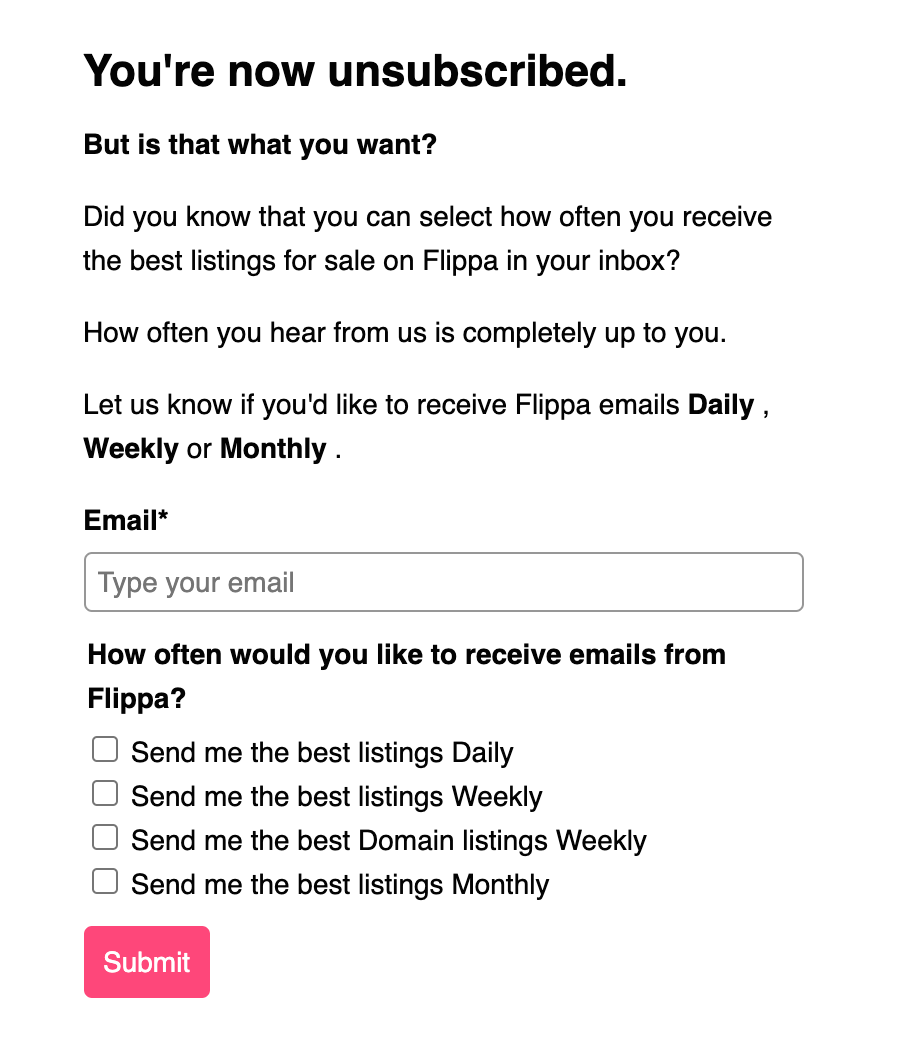Email marketers don't have to contend with constantly changing search algorithms and ranking factors—but that doesn't mean that an email sent is an email received. It's very possible that your marketing emails, and even your transactional emails, will never make it to the recipient.
At Mailshake, we tell our clients that while we can automate the way they send email, we can't guarantee that their emails will actually get into their subscribers' inboxes, much less get opened. But we do have some tips for how to maximize your email deliverability, so you can be sure your messages don't go to spam and result in long-term damage to your business email account.
5 factors that can decrease email deliverability
All emails pass through the provider's ISP (internet service provider) gateway, and the ISP will block any email it thinks is spam. Here are some of the factors that it considers to make that decision.
1. Low sender score and reputation
Sender score is a metric created by Validity that measures your email sender reputation and how email service providers rate your IP address. It considers things like the number of spam complaints you receive, how many unknown or inactive subscribers are in your email list, and whether your domain is on any industry blocklists.

If you have a low sender score, you'll almost certainly have an email deliverability problem.
2. Spammy email content
Spam filters try to identify content that violates email providers' policies. They use algorithms to identify words or phrases that spammers use and look out for bad headers and bulky attachments. And these filters are pretty good: that's why your Gmail spam folder is probably filled to the brim.
The chance of triggering a spam filter is always higher for new recipients, so you need to be extra careful with spam-triggering phrases like "discount," "% off," or "free" when sending to new recipients. On top of going straight to the spam folder, this can risk harming your sender reputation if people report your email or delete it without opening.
3. High bounce rates
When an email bounces, it means that you sent a message to an invalid email address—it can't be delivered because it has nowhere to go. A high email bounce rate indicates one of two things:
You're messaging people you don't know without their consent (not good).
You're not closely managing your email list (also not good).
4. Negative recipient actions
You want the recipient to do something when they get your message: open it, click a link in the email, star it for later, or even reply to it. Those are all positive signals that your content is relevant. If your message goes unopened, immediately deleted, or placed in the spam folder, it's a red flag.
5. Clone phishing attacks
Hackers will often clone a business's display name and forge email headers or messages that look like the business's. It's called spoofing: the goal is to trick your subscribers into thinking a business they know sent them a legitimate message. The message usually contains links or CTAs that redirect users to pages where they're asked to submit sensitive personal information.
Of course, these emails aren't actually coming from your account—but they can impact the trust subscribers have in your brand. It can lead to people deleting your real emails more often without opening them or marking them as spam. Actions like this can result in a poor sender reputation that affects your email deliverability.
7 best practices to improve email deliverability
So you know what can tank your email deliverability rates, but how do you make sure those things don't happen? Here are seven tactics we've found help our clients improve their email deliverability.
1. Warm up your recipients
Thanks to the domain name system (DNS), everything on the internet—including email addresses—has two identifying addresses: the domain name address and the IP address. And if your IP address has a bad reputation, the chances of successfully delivering a message from that address are lower.
To establish your IP's credibility, you need to warm up your email account. At Mailshake, whenever we're sending to a new list, we start by sending emails in small batches. We also avoid sending a high volume of emails in one day or sending emails every day.
Gradually, as emails are received and opened by active users, the ISP will start to trust your IP, and you can increase the number of emails you send. But, of course, you should only send an email when you have something valuable to offer. (And make sure your email frequency generally lines up with your industry's standards).
2. Do a double opt-in confirmation
To reduce your bounce rate, you want to be sure all the emails on your list are actual email addresses. You can do this with email verification tools, but your best bet is to have a double opt-in confirmation. That just means that when someone gives you their email address, they get an email asking them to confirm it.
Here's the double opt-in confirmation email I got from BuzzSumo. All I had to do was click the link, and that was that—not much effort from the user and a lot of benefit for the sender. (Notice that they're super straightforward about why they're sending the email: "to confirm that this is your real email address." Be transparent with your users so they're more likely to follow through.)

This not only ensures that the email addresses are real, but it also ensures that the subscribers actually want to hear from you.
3. Make the opt-out process easier
It's not just good practice to allow your email subscribers to change their minds: it's also a legal requirement. The CAN-SPAM Act requires email marketers to state that a subscriber can unsubscribe at any time and give them clear instructions for doing so.
I signed up for the Flippa newsletter because I'm personally curious about the value of different online businesses. Flippa offers users options for managing their email preferences or unsubscribing from their newsletter.

Clicking on Unsubscribe brings you to the screen below.

Flippa's opt-out process requires only a single click—no questions asked. But it also gives the user the option to rejoin the email list, even offering different selections for how often to hear from them.
As the sender, your aim should be to increase engagement rates. Creating an easy opt-out process makes sure your email list is up to date and relevant. Don't try to trick people into staying on your list if they don't want to be there—it won't do you any favors.
4. Be consistent with your sender name
Sending emails from a consistent name helps recipients get to know your brand. Sending emails from a wide variety of sender names has the opposite effect: recipients don't know who they're hearing from and whether or not they want to be hearing from them to begin with.
When I signed up for a UK business school's newsletter, I got emails from at least six different sender names—I didn't know which were valuable, and it made me much more likely to click delete since I didn't know what I'd be getting if I opened the email.
You can keep things simple and send from your brand name (e.g., Shopify Digest), but it can be a little more personal if you use your first name and your company's name (e.g., Deb at Zapier or Uche from Bolt).

It's weird that I have to say this, but don't invent a person to have your emails come from. Your sender name should be that of a real human—ideally the one actually writing or scheduling the email.
5. Set subscriber expectations
Setting expectations is a good starting point when developing any kind of relationship, and email subscriptions are no exception. In the welcome email series you send to your subscribers, you should share:
The type of content you'll provide
How frequently you'll contact subscribers
A sample of the content you'll send them
Here's the welcome email I received when I signed up for The Balance's newsletter:

Once you've set those expectations, you need to deliver on them. This is the best way to grow an engaged audience that boosts your deliverability.
6. Segment your email list
Segmenting your audience can help improve email deliverability by increasing your chances of sending relevant content to subscribers, making them more likely to open your emails.
Here are six high-value audiences you can target with segmentation, but your segmentation options are almost endless—and they'll change depending on your industry and your business. The bottom line is that your subscribers don't want a bulk email blast. They want personalized emails that speak to their specific pain points.
7. Clean your email list
If subscribers aren't engaging with your emails, you need to remove them from your email list. I know, you want to have as many subscribers as possible, but an unengaged subscriber can do you much more harm than good.
You should clean your email list regularly. That means removing people who've stopped opening your emails and periodically verifying the email addresses on your list. Email addresses get deactivated all the time as users move to different companies or stop paying for a domain.
One of our largest clients learned this lesson the hard way. They noticed that their email deliverability rates were dropping rapidly, and when they looked into the issue, they discovered that about 10% of their subscribers were using email addresses belonging to a domain that no longer existed. Their business development team discovered that the subscribers' company merged with a Fortune 500 firm and moved over to a new email platform and domain. Once our client removed the inactive email addresses from the list, their email deliverability rate returned to normal.
Here's more detail on how to clean your email list.
Wrapping up
The great thing about focusing on email deliverability is that it has ripple effects for engagement rates: low engagement means low deliverability, but high deliverability can mean high engagement. So keep an eye on your deliverability, and implement these best practices to make sure your emails are getting into your audience's inboxes—and making an impact.
This was a guest post from Sam Molony from Mailshake. Want to see your work on the Zapier blog? Read our guidelines, and get in touch.





